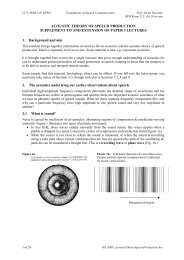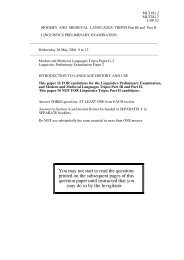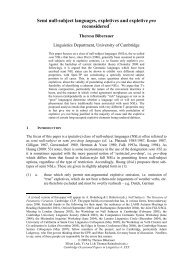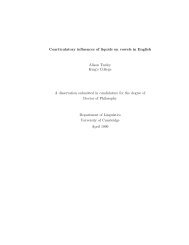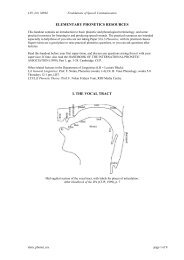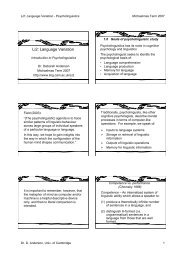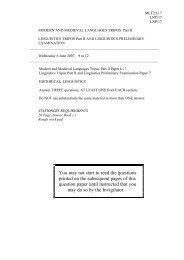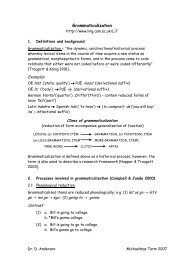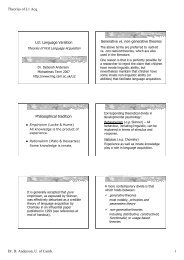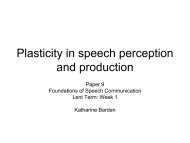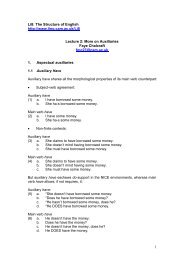ACOUSTIC THEORY OF SPEECH PRODUCTION ... - Ling.cam.ac.uk
ACOUSTIC THEORY OF SPEECH PRODUCTION ... - Ling.cam.ac.uk
ACOUSTIC THEORY OF SPEECH PRODUCTION ... - Ling.cam.ac.uk
Create successful ePaper yourself
Turn your PDF publications into a flip-book with our unique Google optimized e-Paper software.
Paper 9 etc: M4_AcThSpProd 5 of 20<br />
4. The Acoustic Theory of Speech Production [Gunnar Fant & others c.1950-60]<br />
source<br />
vocal tr<strong>ac</strong>t transfer<br />
function<br />
radiation<br />
char<strong>ac</strong>teristic<br />
output<br />
(sound pressure)<br />
Examples of different types of source and vocal tr<strong>ac</strong>t shape. (Mid-sagittal sections)<br />
[e] [s] [m]<br />
output location<br />
sound source<br />
Output depends on:<br />
1. Source spectrum:<br />
• periodic (narrow/complete constriction at glottis → regular vocal fold vibration)<br />
• aperiodic (incomplete laryngeal or supralaryngeal constriction → turbulence noise)<br />
• mixed (periodic (phonated/voiced) + turbulence noise)<br />
2. Transfer function: determined by length and shape of vocal tr<strong>ac</strong>t<br />
a. vocal tr<strong>ac</strong>t length – longer vocal tr<strong>ac</strong>ts have lower natural frequencies (i.e. resonances)<br />
b. vocal tr<strong>ac</strong>t shape – strictly, the cross-sectional area at e<strong>ac</strong>h point along the VT, simply<br />
modelled as the cross-sectional area at the point or points of maximal constriction<br />
3. Radiation function: attenuates low frequencies as they emerge at the lips (c. +6 dB per octave)<br />
A resonator <strong>ac</strong>ts as a filter on the original source of sound. Think of it as rearranging the input energy<br />
so that frequencies that are at or near the resonance frequencies are amplified, at the expense of those<br />
frequencies that are not near the resonance frequencies.<br />
Figure 7 on <strong>ac</strong>companying sheet illustrates these principles. It shows spectra of<br />
• the glottal source (periodic, dropping off at -12 dB per octave for modal voice)<br />
• the vocal tr<strong>ac</strong>t transfer function, when the vocal tr<strong>ac</strong>t is unconstricted, as for schwa.<br />
• the radiation function (always the same: +6 dB per octave)<br />
• the final output spectrum<br />
At its simplest, just think about the process as one of melding a series of independent patterns so that<br />
the final pattern shows the combined influence of all of the initial and intermediate patterns.<br />
M4_0708_AcousticTheorySpeechProduction_07-8.doc



